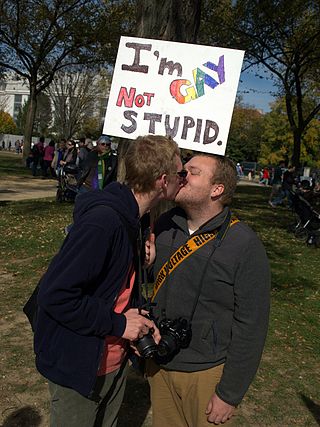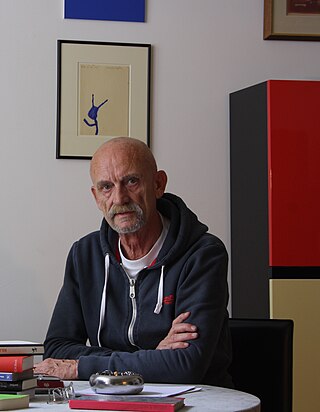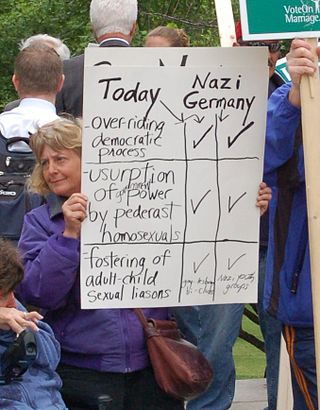Related Research Articles

Magnus Hirschfeld was a German physician and sexologist.

Biphobia is aversion toward bisexuality or people who are identified or perceived as being bisexual. Similarly to homophobia, it refers to hatred and prejudice specifically against those identified or perceived as being in the bisexual community. It can take the form of denial that bisexuality is a genuine sexual orientation, or of negative stereotypes about people who are bisexual. Other forms of biphobia include bisexual erasure.
Heterosexism is a system of attitudes, bias, and discrimination in favor of female–male sexuality and relationships. According to Elizabeth Cramer, it can include the belief that all people are or should be heterosexual and that heterosexual relationships are the only norm and therefore superior.
Societal attitudes towards same-sex relationships have varied over time and place, from requiring all males to engage in same-sex relationships to casual integration, through acceptance, to seeing the practice as a minor sin, repressing it through law enforcement and judicial mechanisms, and to proscribing it under penalty of death. In addition, it has varied as to whether any negative attitudes towards men who have sex with men have extended to all participants, as has been common in Abrahamic religions, or only to passive (penetrated) participants, as was common in Ancient Greece and Ancient Rome. The widespread concept of homosexuality as a sexual orientation and sexual identity is a relatively recent development, with the word itself being coined in the 19th century.

Terms used to describe homosexuality have gone through many changes since the emergence of the first terms in the mid-19th century. In English, some terms in widespread use have been sodomite, Achillean, Sapphic, Uranian, homophile, lesbian, gay, effeminate, queer, homoaffective, and same-sex attracted. Some of these words are specific to women, some to men, and some can be used of either. Gay people may also be identified under the umbrella terms LGBT.

Lesbian, gay, bisexual and transgender (LGBT) rights in Germany rank among the highest in the world and have evolved significantly over the course of the last decades. During the 1920s and early 1930s, lesbian and gay people in Berlin were generally tolerated by society and many bars and clubs specifically pertaining to gay men were opened. Although same-sex sexual activity between men was already made illegal under Paragraph 175 by the German Empire in 1871, Nazi Germany extended these laws during World War II, which resulted in the persecution and deaths of thousands of homosexual citizens. The Nazi extensions were repealed in 1950 and same-sex sexual activity between men was decriminalized in both East and West Germany in 1968 and 1969, respectively. The age of consent was equalized at 14 in East Germany in 1988 and in unified Germany in 1994.

Different from the Others is a silent German melodramatic film produced during the Weimar Republic. It was first released in 1919 and stars Conrad Veidt and Reinhold Schünzel. The story was co-written by Richard Oswald and Magnus Hirschfeld, who also had a small part in the film and partially funded the production through his Institute for Sexual Science. The film was intended as a polemic against the then-current laws under Germany's Paragraph 175, which made homosexuality a criminal offense. It is believed to be the first pro-gay film in the world.
Sexual orientation discrimination is discrimination based on sexual orientation and/or sexual behaviour.

Martin Dannecker is a German sexologist and author.
The Lex Scantinia is a poorly documented Roman law that penalized a sex crime (stuprum) against a freeborn male minor. The law may also have been used to prosecute adult male citizens who willingly took a passive role in having sex with other men. It was thus aimed at protecting the citizen's body from sexual abuse (stuprum), but did not prohibit homosexual behavior as such, as long as the passive partner was not a citizen in good standing. The primary use of the Lex Scantinia seems to have been harassing political opponents whose lifestyles opened them to criticism as passive homosexuals or pederasts in the Hellenistic manner.

Tabu Homosexualität: Die Geschichte eines Vorurteils is a standard work of Germanophone research into homophobia, written by German sociologist, ethnologist, and sexologist Gisela Bleibtreu-Ehrenberg, and first published in 1978.
Angst und Vorurteil: AIDS-Ängste als Gegenstand der Vorurteilsforschung is a sociology book written by German sociologist, ethnologist, and sexologist Gisela Bleibtreu-Ehrenberg that was first published in 1989.
There are a number of passages in the Hebrew Bible that have been interpreted as involving same-sex sexual acts, desires, and relationships. The passages about homosexual individuals and sexual relations in the Hebrew Bible are found primarily in the Torah and have been interpreted as referring primarily to male homosexual individuals and sexual practices.

Military brothels were set up by Nazi Germany during World War II throughout much of occupied Europe for the use of Wehrmacht and SS soldiers. These brothels were generally new creations, but in the west, they were sometimes set up using existing brothels as well as many other buildings. Until 1942, there were around 500 military brothels of this kind in German-occupied Europe. Often operating in confiscated hotels and guarded by the Wehrmacht, these facilities served travelling soldiers and those withdrawn from the front. According to records, at least 34,140 European women were forced to serve as prostitutes during the German occupation of their own countries along with female prisoners of concentration camp brothels. In many cases in Eastern Europe, teenage girls and women were kidnapped on the streets of occupied cities during German military and police round ups called łapanka in Polish or rafle in French.

Queer anarchism, or anarcha-queer, is an anarchist school of thought that advocates anarchism and social revolution as a means of queer liberation and abolition of hierarchies such as homophobia, lesbophobia, transmisogyny, biphobia, transphobia, heteronormativity, patriarchy, and the gender binary. People who campaigned for LGBT rights both outside and inside the anarchist and LGBT movements include John Henry Mackay, Lucía Sánchez Saornil, Adolf Brand and Daniel Guérin. Individualist anarchist Adolf Brand published Der Eigene from 1896 to 1932 in Berlin, the first sustained journal dedicated to gay issues.

Sexual stigma is a form of social stigma against people who are perceived to be non-heterosexual because of their beliefs, identities or behaviors. Privileged individuals, or the majority group members, are the main contributors of placing sexual stigmas on individuals and their minority group. It is those who hold a higher status that determine within a society which groups are deemed unworthy of a higher status by labeling their specific actions or beliefs. Stereotypes are then produced which further the debilitating effects of the label(s) placed on group members with non-heterosexual beliefs or practices.
The attribution-value model is a framework for understanding individual differences in prejudice, developed by Chris Crandall and colleagues. It states that not only do minorities possess undesirable characteristics incongruent with the majority, but also that minorities are also responsible for them. For example, overweight individuals are viewed as “lazy” and unable to control themselves. This belief that targeted groups should be held accountable for their status arouses negative emotional reactions towards them.
Karl-Günther Heimsoth, also known as Karl-Guenter Heimsoth was a German physician, polygraph, and politician. Heimsoth was a member of the Nazi Party and later the Communist Party of Germany.

There is a widespread and long-lasting myth alleging that homosexuals were numerous and prominent as a group in the Nazi Party or the identification of Nazism with homosexuality more generally. It has been promoted by various individuals and groups both before and after World War II, especially by left-wing Germans during the Nazi era and the Christian right in the United States more recently. Although some gay men joined the Nazi Party, there is no evidence that they were overrepresented. The Nazis harshly criticized homosexuality and severely persecuted gay men, going as far as murdering them en masse. Therefore, historians regard the myth as having no merit.

Die BIF – Blätter Idealer Frauenfreundschaften, subtitled Monatsschrift für weibliche Kultur, was a short-lived lesbian magazine of Weimar Germany, published from either 1925 or 1926 until 1927 in Berlin. Founded by lesbian activist Selli Engler, Die BIF was part of the first wave of lesbian publications in history and the world's first lesbian magazine to be published, edited and written solely by women.
References
- ↑ Society of Lesbian and Gay Anthropologists Homepage
- ↑ Society of Lesbian and Gay Anthropologists Newsletter, October 1991, Vol. 13, No. 3: pp. 43–75
- ↑ Biographical and bibliographical notes on the inside dust jacket of Bleibtreu-Ehrenberg's book Tabu Homosexualität (1st ed.), on page 2 of her book Angst und Vorurteil, and on page 2 of her book Vom Schmetterling zur Doppelaxt.
- ↑ Preface to the German edition (1986) of Theo Sandfort's Dutch study published in English as The sexual aspect of paedosexual relations: The experience of 25 boys with men (1981, 1st reprint 1983, 2nd reprint 1987)
- ↑ Der pädophile Impuls – Wie lernt ein junger Mensch Sexualität?. (1985/88)
- ↑ Sandfort, Theo (1987), Boys on their contacts with men: A study of sexually expressed friendships, New York: Global Academic Publishers
- ↑ Sandfort, Theo (1992), "The argument for adult-child sexual contact: A critical appraisal and new data", in O'Donohue; Geer (eds.), The sexual abuse of children, Hillsdale, New Jersey: Lawrence Erlbaum Associates
- ↑ Sandfort, Theo (1994). "The Sexual Experiences of Children". Paidika. 3 (2).
- ↑ Sandfort, Theo; Rademakers, Jany, eds. (2000), Childhood Sexuality: Normal Sexual Behavior and Development , Haworth Press, ISBN 0-7890-1199-9
- ↑ Jantzen, Wolfgang (1980). Die Entwicklung des Begriffs Imbezillität als Beispiel des gesellschaftlichen Umgangs mit Minderheiten – Ein Beitrag zur Ideengeschichte von Psychiatrie und Behindertenpädagogik, presented on the 17th annual conference of Germanophone social workers, Essen, 1980
- ↑ E. J. Haeberle (1984): Einführung in den Jubiläums-Nachdruck von Magnus Hirschfeld, „Die Homosexualität des Mannes und des Weibes“, 1914 Archived January 7, 2009, at the Wayback Machine (see footnote 51 and the sentence tagged by this footnote)
- ↑ Wolfram Setz. Preface, in: Erich Bethe (1988). Die dorische Knabenliebe: Ihre Ethik und ihre Idee, Berlin: Verlag rosa Winkel
- ↑ Karl Werner Böhm (1991). Zwischen Selbstzucht und Verlangen – Thomas Mann und das Stigma Homosexualität, Königshausen & Neumann, Würzburg. ISBN 3-88479-558-9
- ↑ Blazek, Helmut (1996). Rosa Zeiten für rosa Liebe, Frankfurt/Main: Fischer, ISBN 3-596-12819-6
- ↑ Olaf Brühl: frauen männer geschichte in the Leftist weekly Junge Welt , August 15, 2002
- ↑ Andreas Ismail Mohr. Seminar paper „Ich mache meinen Gesicht hart wie einen Kiesel!“ – Homosexuelle zwischen Ausgrenzung und Annahme in den abrahamitischen Religionen Archived October 8, 2007, at the Wayback Machine , presented on the German Ecumenic Church Congregation 2003, Themenbereich 3: Podienreihe "Und diese Liebe auch! – Homosexuelle und Kirche" (Word file, see commented Literaturhinweise at the end)
- ↑ Bontke, Sarah (2007). Seminararbeit zur Rechtsgeschichte der Homosexualität [ permanent dead link ], Ruhr-Universität Bochum, pp. 1–13
- ↑ Jakob Michelsen: Mannmännliche Sexualität im 18. Jahrhundert am Beispiel Hamburgs Archived October 8, 2007, at the Wayback Machine (PDF file, see footnote 2)
- ↑ Buchtipps Archived February 19, 2007, at the Wayback Machine ("Recommended reading") of the Swiss "Coming-Out-Gruppe" Der Spot 25 for homosexuals up to 25 years of age
- ↑ Markus Bernhardt: Sein Kampf, in Gigi – Zeitschrift für Sexuelle Emanzipation, published by the new Scientific-Humanitarian Committee , on the gay neo-Nazi Michael Kühnen
- ↑ Dannecker, Martin (1984).Towards a Theory of Homosexuality: Socio-Historical Perspectives Archived December 17, 2012, at archive.today , Journal of Homosexuality, Volume: 9 Issue: 4, 1984
- ↑ Moormann, Eric M. (1985). "Een bron van tedere, innige ervaringen": Gedachten naar aanleiding van het hedendaagse onderzoek inzake homoseksualiteit in het oude Griekenland, in Hermeneus: Tijdschrift voor antieke cultuur, vol. 57, no. 5, December 1985, p. 278
- ↑ Greenberg, David F. (1988). The Construction of Homosexuality, University of Chicago Press, pp. 186, 242–246, 248–251, 253–255
- ↑ Gerard; Hekma (1989). The Pursuit of Sodomy: Male Homosexuality in Renaissance and Enlightenment Europe, Haworth Press, pp. 201, 204, 261
- ↑ Halsall, Paul (1989). Homosexuality in History: A Partially Annotated Bibliography, on Fordham University, the Jesuit University of New York
- ↑ Muxfeldt, Kristina (1993). Political Crimes and Liberty, or Why Would Schubert Eat a Peacock? [ permanent dead link ], 19th-Century Music, Vol. 17, No. 1, Schubert: Music, Sexuality, Culture. (Summer, 1993), pp. 47–64 (see footnote 81)
- ↑ Gunther, Scott (1995). La construction de l’identité homosexuelle dans les lois aux État-Unis et en France Archived July 31, 2012, at archive.today , (Bibliographie: III. Histoire de l’Homosexualité – Ouvrages Généraux), DEA thesis, Ecole des Hautes Etudes en Sciences Sociales, Paris, France
- ↑ Noordam, D. J. (1995). Riskante relaties: Vijf eeuwen homoseksualiteit in Nederland, 1233–1733, Uitgeverij Verloren, ISBN 90-6550-513-X, pp. 26 (footnote 30), 31 (footnote 50), 32 (footnote 55), 46 (footnote 21), 68 (footnote 60)
- ↑ Senelick, Laurence (2000). The Changing Room: Sex, Drag and Theatre, Routledge, pp. 35, 37
- ↑ Berenbaum & Peck (eds.; 2002). The Holocaust and History: The Known, the Unknown, the Disputed, and the Reexamined, Indiana University Press, p. 343 (see footnote 10)
- ↑ Rydström, Jens (2003).Sinners and Citizens: Bestiality and Homosexuality in Sweden, 1880–1950, University of Chicago Press, pp. 5, 336–337, 341, 384
- ↑ Whisnant, Clayton John (2008). Introduction: Gay German History: Future Directions?, Journal of the History of Sexuality – Volume 17, Number 1, January 2008, pp. 1–10
- ↑ The University of Chicago Library Guide to Gay and Lesbian Resources: II History and Ethnology, 15. Ethnographic and anthropological works
- ↑ Halsall, Paul. Homosexuality and Catholicism Bibliography: Section III. Lesbian and Gay Religious History, on Fordham University, the Jesuit University of New York
- ↑ Entry on Tabu Homosexualtät (both editions) on Worldcat.org (any US state must be entered first in order to get results for availability of the book in the particular state's libraries)